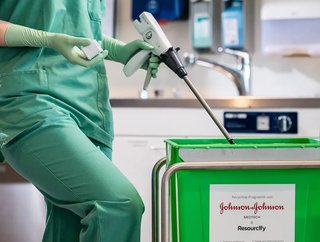Supplier Collaboration Key to Johnson & Johnson Climate Push

By expanding its supplier sustainability programme, Johnson & Johnson is demonstrating its commitment to stemming the prevailing tide that is climate change.
The organisation has taken sustained, long-term action to reduce greenhouse gas (GHG) emissions, encouraging suppliers to do the same. It also works with like-minded partners to promote and advance environmental health equity.
Goals include sourcing 100% of its electricity from renewable sources by 2025 and reducing emissions by 44% by 2030.
Meanwhile, the company is aiming for 80% of its suppliers to have science-based targets by 2028 and is striving for net-zero emissions across its value chain by 2045.
Moving towards net zero
Johnson & Johnson is wasting little time in attempting to achieve its goals, with 65% of its global electricity already coming from renewable sources.
The pharmaceutical giant has built more than 50 on-site renewable energy systems on the grounds of properties in 20 countries and has executed 15 contracts for off-site renewable electricity procurement.
Additionally, it has finalised multiple deals in the US, Canada and Brazil that, when operational, will allow it to source the equivalent of 100% renewable electricity for its operations in these countries.
Worth noting is the fact Johnson & Johnson is also producing or procuring the equivalent of 100% of its electricity used across European operations from renewable sources. Twelve countries, where the business has J&J MedTech and Janssen operations, are included: Belgium, France, Germany, Greece, Ireland, Italy, the Netherlands, Poland, Spain, Sweden, Switzerland and the UK.
This is thanks to three deals that led to the construction of two new wind farms and one new solar field in Spain, adding to existing on-site and off-site electricity projects.
Elsewhere, through its CO2 Capital Relief Program, Johnson & Johnson has allocated up to US$40m per year for energy efficiency programmes at its most energy-intensive manufacturing and R&D sites. Each project must show the potential for both emissions reductions and a financial return of at least 15%.
Since launching the programme in 2005, approximately 270 projects have been completed that have helped to avoid around 320,000 metric tons of GHG per year.
What's more, Johnson & Johnson is continuing to expand the use of geothermal energy to provide substantial reductions in GHG emissions. At its Janssen campus in Beerse, Belgium, multiple wells – each approximately 1.6 miles deep – are using innovative geothermal energy to help heat and cool buildings across the site.
At the Ethicon campus in Cincinnati, Ohio, a closed-loop, geothermal system has been installed, with the capacity to provide heating and cooling to the entire 45-acre campus while substantially reducing emissions.

Supporting the value chain
A collaborative approach has been taken by Johnson & Johnson as it looks to tackle the environmental challenges of today.
Over the years, it has been committed to accelerating environmental and social improvements across the value chain.
The Johnson & Johnson Supplier Sustainability Program is set to include all suppliers by 2025, meaning even more opportunities for engagement and collaboration on its joint environmental and social priorities.
In 2021, Johnson & Johnson joined with nine other leaders in the pharmaceutical industry to launch Energize, a first-of-its-kind initiative to help decarbonise the global pharmaceutical supply chain. The program aims to educate key industry suppliers on renewable procurement opportunities and help them in their transition to renewable energy. The program has registered hundreds of suppliers on the platform.
And in 2022, a new collaboration called Activate was launched, bringing together five pharmaceutical companies to support active pharmaceutical ingredient (API) suppliers in their decarbonisation efforts.
For many years, the company participated in coalitions that publicly supported actions to promote a low-carbon economy and mitigate climate change at scale. These included schemes like the Clean Energy Buyers Alliance and the Climate Leadership Council to share best practices and encourage the advancement of renewable energy and market-based climate policies.
Johnson & Johnson supports the Paris Climate Agreement through various platforms such as the ‘We Are Still In/America Is All In' campaign and previously signed an open letter to President Biden calling for an ambitious US emissions reduction target.
******
Check out the latest edition of Supply Chain Magazine and sign up to our global conference series – Procurement and SupplyChain LIVE 2024.
******
Supply Chain Digital is a BizClik brand.






